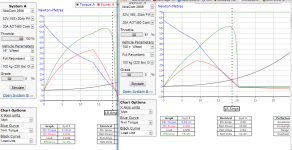bowlofsalad said:
cal3thousand said:
(BTW, your motor will be happier if you stay away from the 700c/29er wheels. 26" is the largest that I go now. If you are going 700c because of the speed, just go for more voltage in a 26" or 24" instead. (26" parts being MUCH more prevalent makes things easier)
Could you please deeply elaborate?
Maybe OP is choosing a 700c rim because his frame accomodates 700c (622).
Sure, unless the frame that I am using CANNOT use smaller wheels, I will tend to stay away from 700c. Only case I see here, are 700c frames with non-disc brakes and frames with BB that are too low to begin with. I still have a 700c bike that I'm getting rid of now (It was my noob bike).
If a frame is 700c and disc, I would drop it down to 26". (This is for ebikes only). Reason being is that a motor is better off when the effective gear ratio that it has to drive is smaller and the motor is allowed to spin. This creates less heat and waste.
Basically, speed should not be the determining factor for selecting 700c wheels. One should not say "I am choosing a 700c wheel, because my bike will go faster with it." That same person should stick with a 26" wheel and volt up to the desired speed.
You'll here it often on this site from the highly experienced (like Dogman): "Gear down and volt up"



